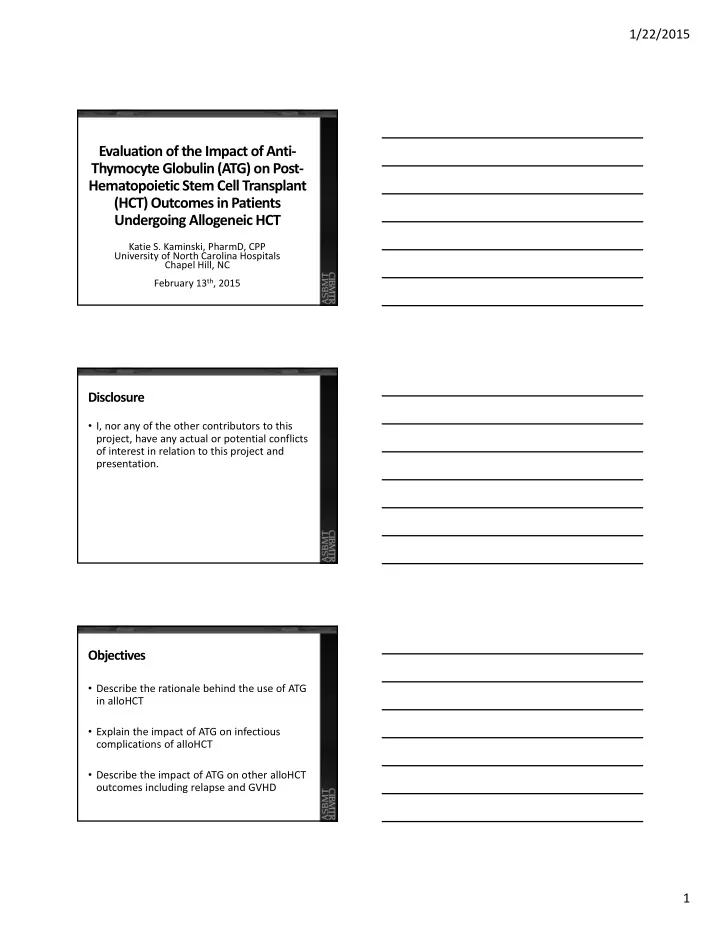

1/22/2015 Evaluation of the Impact of Anti ‐ Thymocyte Globulin (ATG) on Post ‐ Hematopoietic Stem Cell Transplant (HCT) Outcomes in Patients Undergoing Allogeneic HCT Katie S. Kaminski, PharmD, CPP University of North Carolina Hospitals Chapel Hill, NC February 13 th , 2015 Disclosure • I, nor any of the other contributors to this project, have any actual or potential conflicts of interest in relation to this project and presentation. Objectives • Describe the rationale behind the use of ATG in alloHCT • Explain the impact of ATG on infectious complications of alloHCT • Describe the impact of ATG on other alloHCT outcomes including relapse and GVHD 1
1/22/2015 Background • Several studies have demonstrated the positive effects of ATG on chronic graft ‐ versus ‐ host disease (cGVHD) when used prior to alloHCT • There are mixed results on the impact on overall survival and relapse rates with the use of ATG Recent data has shown that ATG use in the reduced intensity conditioning (RIC) setting is associated with decreased overall survival — Increased infection rates may be a potential cause for this mortality difference Blood. 2011;117:6963 ‐ 70. Biol Blood Marrow Transplant . 2014; http://dx.doi.org/10.1016/j.bbmt.2014.01.016 [Epub ahead of print]. Background • University of North Carolina Hospitals (UNCH) performs 180 ‐ 200 HCTs annually ~40% are alloHCTs ~60% of alloHCTs are from matched unrelated donors (MUD) or mismatched related donors (MMRD) — UNCH protocols utilize ATG for all MUD and MMRD transplants for GVHD prophylaxis — Conditioning regimens for MUD and MMRD: Busulfan ‐ fludarabine (Bu ‐ Flu) Recent increase in use of busulfan ‐ cyclophosphamide (Bu ‐ Cy) and total body irradiation (TBI) in myeloablative conditioning (MAC) setting Objectives • To test the hypothesis that the addition of ATG to alloHCT myeloablative conditioning (MAC) and reduced intensity conditioning (RIC) regimens, when compared to non ‐ ATG regimens, results in a significant difference in: Primary endpoint: — Incidence of infections Secondary endpoints: — Incidence and severity of acute graft ‐ versus ‐ host disease (aGVHD) — Relapse — Mortality 2
1/22/2015 Methods • Retrospective cohort study of adult alloHCT patients at UNCH from 2006 ‐ 2013 through day +180 125 +ATG, 125 –ATG Inclusion criteria: MRD, MUD, and MMRD alloHCT patients who underwent a MAC or • RIC transplant Age ≥ 18 years • Exclusion criteria: Active infection at the time of transplant • Transplant source other than peripheral blood or bone marrow • Patients receiving haploidentical transplants • Patients enrolled in clinical trials involving ATG • Patients with multiple transplants • Results – Study Participants MAC (n=63) +ATG (n=125) MRD (n=10) MMRD (n=2) MUD (n=113) RIC (n=62) AlloHCT Patients* (n=250) MAC (n=63) ‐ ATG (n=125) MRD (n=103) MMRD (n=1) MUD (n=21) RIC (n=62) Results – Infection Rates Mean Infection Count per Subject by ATG Group and Conditioning Regimen ‐ ATG +ATG p ‐ value MAC 3.3 4.9 0.01 RIC 2.0 3.3 0.015 Total 2.7 4.1 0.0007 • Factors other than ATG use with significant impact on infection incidence in multivariate analysis: Conditioning regimen (p=0.0034) Increasing age (p=0.0129) 3
1/22/2015 Results – Infection Rates Infection Type and Frequency by ATG Group 120 100 80 60 40 nonATG ATG 20 0 Infection Type Results – Infection Rates Infection Type and Frequency by ATG Group in MAC Patients 60 50 40 30 MAC nonATG 20 MAC ATG 10 0 Results – Infection Rates Infection Type and Frequency by ATG Group in RIC Patients 60 50 40 30 20 RIC nonATG 10 RIC ATG 0 4
1/22/2015 Results – Graft versus Host Disease Incidence of any GVHD* by ATG Group and Conditioning Regimen ‐ ATG +ATG p ‐ value MAC 46 (73%) 50 (79%) 0.658 RIC 40 (65%) 45 (73%) 0.82 Total 86 (68%) 95 (76%) 0.167 *occurrence of GVHD of any grade in any organ Results – Mortality Mean Overall Survival by ATG Group Results – Relapse or Death Mean Relapse ‐ Free Survival Time by ATG Group 5
1/22/2015 Audience Response Question • Incidence of what type of infection was most significantly impacted by ATG use? A) Gram positive B) Gram negative C) Viral D) Fungal Limitations • Data collection limited to day +180 • Difficult to detect true differences in GVHD rates as per protocol at UNCH most higher risk patients (MUD, MMRD) receive ATG • Infection data limited to culture ‐ documented infections Conclusions and Future Directions • ATG use is associated with increased infection rates in alloHCT patients, with greater impact in the RIC setting Greatest increase is seen in rate of viral infections (CMV, HSV, HHV ‐ 6) • ATG use does not appear to be associated with an increase in mortality in the first 180 days post ‐ HCT • In the future, we plan to further examine outcomes related to increased infection rates and assessing all outcomes beyond day +180 6
1/22/2015 Acknowledgements • Co ‐ Investigators Ryan Beechinor, PharmD; Rachel Lebovic, PharmD; Mary Roth, PharmD • Physician Support Katarzyna Jamieson, MD; Pearlie Chong, MD; Thomas Shea, MD • Data Support Andrew Sharf, Nicolas Ballarini, Ananta Bangdiwala Anastasia Ivanova, PhD • Mentorship Kamakshi Rao, PharmD, BCOP, CPP, FASHP Evaluation of the Impact of Anti ‐ Thymocyte Globulin (ATG) on Post ‐ Hematopoietic Stem Cell Transplant (HCT) Outcomes in Patients Undergoing Allogeneic HCT Katie S. Kaminski, PharmD, CPP University of North Carolina Hospitals Chapel Hill, NC February 13 th , 2015 7
Recommend
More recommend